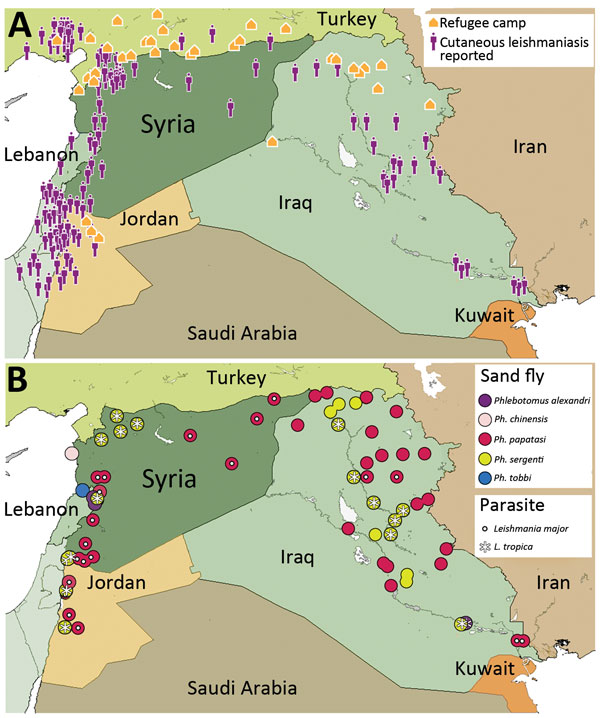Using AI to control energy for indoor agriculture
30 September 2024
Published online 27 May 2016
Disturbing statistics show the return of Aleppo boil in conflict zones and neighbouring regions as people are displaced across borders.

© Waleed Al-Salem et al.
Enlarge image
The disease, properly known as cutaneous leishmaniasis, is caused by a parasite in the blood stream and transmitted through the bite of the sand fly. It provokes disfiguring lesions on the body, which are liable to secondary infection.
Hundreds of thousands of people across the Middle East region are now affected by cutaneous leishmaniasis, which until recently was contained to areas around Aleppo and Damascus in Syria.
The figures, which are published yesterday in a PLOS editorial, have spiked with the advent of war.
“The numbers are looking very bad and there’s no access to intra lesional antimony compounds …We're seeing lots of diseases, including leishmaniasis… in these conflict zones and we need to ring fence them or risk another situation like Ebola out of the conflict zones in West Africa in 2014,” says Peter Hotez, dean of the US National School of Tropical Medicine, US Science Envoy to the Middle East, and lead author of the PLOS editorial.
Bombed out buildings, disrupted insecticide control, and poor water and sanitation services create a ripe breeding ground for sandflies. Poor health systems mean treatment is difficult to reach or insufficient, and refugees fleeing conflict take the disease into non-immune areas or arrive in endemic areas without immunity themselves.
In Syria, infections reported to the Ministry of Health doubled from 23,000 before the war to 41,000 in 2013. Neighbouring countries, which have received millions of Syrian refugees, have also begun to report large numbers of cases, where previously there were barely any. In Lebanon, the figures jumped to 1,033 in 2013 from six in the previous 12 years. Turkey and Jordan have also reported hundreds of cases.
A similar situation may be occurring in Eastern Libya and Yemen, scientists say. Eastern Libya has reported increasing numbers of leishmaniasis and anecdotal evidence supports the spread of the disease in refugee camps in neighboring Tunisia. In Yemen, roughly 10,000 new cases are reported every year. With Yeminis migrating to Saudi Arabia, the concern is that the disease might spread there too.
Worse, these figures may be significantly underestimated because surveillance systems are badly affected or absent in conflict areas, scientists fear.
“It's nearly impossible to have on the ground tropical disease experts and epidemiologists in Syria, Iraq, eastern Libya so we are only getting glimpses of the situation from refugees fleeing the conflict zones and going to camps in Jordan, Lebanon, Turkey,” says Hotez.
If people know that medicines are there, they will contact the health services and seek treatment.
To try to address this issue, Waleed Al Salem, a consultant for the Saudi Arabian Ministry of Health and a team from the Liverpool School of Tropical Medicine, University of Oxford and US Institute for Health and Metrics used data sets drawn from Arabic and English science publications to create a map of cutaneous leishmaniasis prevalence in Syria and the WHO’s Eastern Mediterranean Region.
The map, published in Emerging Infectious Diseases earlier this month, shows clear correlation between disease, refugee population and sand fly distribution in the region.
Areas under the control of the militant group calling itself Islamic State, including Ar-Raqqah, Diyar Al-Zour and Hasakah, are worst affected. News of 6,500 fresh cases was reported by the Syrian opposition groups and non-governmental organisations, Al Salem says.
Cutaneous leishmaniasis is one of 17 tropical diseases categorized as “neglected” by the WHO. There’s no large-scale drug donation programme and no vaccine capacity in the region. The US Sabin Vaccine Institute is now working with King Saud University to build vaccine development.
The papers both stress the need for more awareness of the disease in order to head off an epidemic. Both recommend better disease monitoring, training for clinicians and vector control in refugee camps and stable areas.
Lebanon may prove a good example of what is possible with political will and scientific collaboration.
Infectious Diseases specialist, Abdul Rahman Bizri, at the Department of Internal Medicine, American University of Beirut, whose paper on the 2013 Leishmaniasis outbreak shed light on the scale of the problem in Lebanon, says that the numbers there were halved in 2014 and are now under control. His latest figures will be published in a new report shortly.
The turnaround, Bizri says, is thanks to a containment response involving Lebanese Ministry of Public Health, WHO office, infectious diseases specialists, dermatologists, and pathologists. Key lessons learned in Lebanon include early detection and treatment, training for doctors, healthcare workers and lab technicians, and continued surveillance after containing the outbreak.
“Most cases in the Middle East are due to the Leishmania tropica anthroponotic form of the disease, which means that humans are the only reservoir of infection. As such, early detection and treatment of infected individuals is the key step,” says Albis Gabrielli, WHO regional advisor for the control of neglected tropical diseases in the Eastern Mediterranean Region.
“From a clinical perspective it will enable a simple and inexpensive case-management protocol and ensure good treatment outcomes. From a public-health standpoint it will reduce likelihood of transmission to other people,” says Gabrielli.
The WHO recommends including access to free diagnosis and treatment in emergency health response packages and in the primary health care structure of affected countries.
“The turning point is often availability of medicines. If people know that medicines are there, they will contact the health services and seek treatment; if not, they won’t,” he says. “In short, it is a matter of prioritization — leishmaniasis must be taken out of neglect.”
doi:10.1038/nmiddleeast.2016.82
Stay connected: